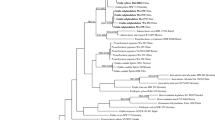Abstract
To clarify the diversity of Astraeus in Japan, 35 collections of Astraeus basidiomata from Japan and Thailand were examined for their morphological characteristics and the nucleotide sequences of the rDNA ITS region and compared with several worldwide Astraeus species. Japanese Astraeus specimens were separated into two groups based on basidiome size, shape of exoperidium, and ornamentation and size of basidiospores. The phylogenetic tree analyses supported the separation, and the morphological groups belonged to different clades. The Japanese Astraeus group 1, morphologically matched to Astraeus hygromerticus var. koreanus, showed the closest phylogenetic relationship with Astraeus hygrometricus from North American and Mediterranean regions, suggesting that the Astraeus group 1 can be indentified as A. hygrometricus var. koreanus. Another Astraeus group, group 2, morphologically matched to A. hygrometricus s.l., showed a distinct monophyletic clade that was separated from A. hygrometricus complexes, indicating an undescribed species.



Similar content being viewed by others
References
Arora D (1986) Mushrooms demystified: a comprehensive guide to the fleshy fungi, 2nd edn. Ten Speed Press, Berkeley
Baseia IG, Galvão TC (2001) Some interesting gasteromycetes (Basidiomycota) in dry areas from northeastern Brazil. Acta Bot Bras 16:1–8
Binder M, Bresinsky A (2002) Derivation of a polymorphic lineage of Gasteromycetes from boletoid ancestors. Mycologia 94:85–98
Bruns TD, Szaro TM, Gardes M, Cullings KW, Pan J, Taylor DL, Horton TR, Kretzer AM, Garbelotto M (1998) A sequence database for the identification of ectomycorrhizal basidiomycetes by sequence analysis. Mol Ecol 7:257–272
Cannon PF, Kirk PM (2007) Fungal families of the world. CAB International, Wallingford
Coker WC, Couch JN (1928) The Gasteromycetes of the eastern United States and Canada. University of North Carolina Press, Chapel Hill
Danielson RM (1984) Ectomycorrhizal associations in jack pine stands in northeastern Alberta. Can J Bot 62:932–939
De Roman M, Claveria V, De Miguel AM (2005) A revision of the descriptions of ectomycorrhizas published since 1961. Mycol Res 109:1063–1104
Gardes M, Bruns TD (1993) ITS primers with enhanced specificity of basidiomycetes: application to the identification of mycorrhizae and rusts. Mol Ecol 2:113–118
Imazeki R, Hongo T (1989) Colored illustrations of mushrooms of Japan, vol II (in Japanese). Hoikusha, Osaka
Ito S (1959) Mycological flora of Japan, vol II. Basidiomycetes no. 5: Agaricales, Gasteromycetales (in Japanese). Yokendo, Tokyo
Kaneko R, Kakishima M (2001) Mycosphaerella buna sp. nov. with a Pseudocercospora anamorph isolated from the leaves of Japanese beech. Mycoscience 42:59–66
Kirk PM, Cannon PF, Minter DW, Stalpers JA (2008) Dictionary of the fungi, 10th edn. CAB International, Wallingford
Kreisel H (1976) Gasteromyzeten aus Nepal II. Feddes Repert 87:83–107
Malajczuk N, Molina R, Trappe JM (1982) Ectomycorrhizal formation in Eucalyptus. I. Pure culture synthesis, host specificity and mycorrhizal compatibility with Pinus radiata. New Phytol 91:467–482
Martin F, Diez J, Dell B, Delaruelle C (2002) Phylogeography of the ectomycorrhizal Pisolithus species as inferred from nuclear ribosomal DNA ITS sequences. New Phytol 153:345–357
Molina R (1979) Pure culture synthesis and host specificity of red alder mycorrhizae. Can J Bot 57:1223–1228
Molina R (1981) Ectomycorrhizal specificity in the genus Alnus. Can J Bot 59:325–334
Molina R (1982) Use of the ectomycorrhizal fungus Laccaria laccata in forestry. I. Consistency between isolates in effective colonization of containerized conifer seedlings. Can J For Res 12:469–473
Molina R, Trappe JM (1982) Patterns of ectomycorrhizal host specificity and potential among Pacific Northwest conifers and fungi. For Sci 28:423–458
Morgan AP (1889) North American fungi: the gasteromycetes. J Cin Soc Nat Hist 12:8–22
Nouhra ER, De Toledo LD (1998) The first record of Astraeus hygrometricus from Argentina. Mycologist 12:112–113
Nylander JAA, Ronquist F, Huelsenbeck JP, Nieves Aldrey JL (2004) Bayesian phylogenetic analysis of combined data. Syst Biol 53:47–67
Petcharat V (2004) Edible Astraeus (Basidiomycota) from Thailand. Nor J Bot 23:499–503
Phillips R (1981) Mushrooms and other fungi of Great Britain and Europe. Pan Books, London
Phosri C, Watling R, Martin MP, Whalley AJS (2004) The genus Astraeus in Thailand. Mycotaxon 89:453–463
Phosri C, Martin MP, Sihanonth P, Whalley AJS, Watling R (2007) Molecular study of the genus Astraeus. Mycol Res 111:275–286
Ronquist F, Heuelsenbeck JP (2003) MrBayes: Bayesian phylogenetic inference under mixed models. Bioinformatics 19:1572–1574
Staněk VJ (1958) 1. rod Astraeus Morg.–Hvězdák. In: Pilát A (ed) Flora ČSR B-1, Gasteromycetes. Československé Akademie, Praha, pp 626–632
Swofford DL (2002) PAUP*: phylogenetic analysis using parsimony (*and other methods). Version 4 beta 10. Sinauer Associates, Sunderland
Tamura K, Dudley J, Nei M, Kumar S (2007) MEGA4: molecular evolutionary genetics analysis (MEGA) software version 4.0. Mol Biol Evol 24:1596–1599
Trappe JM (1967) Pure culture synthesis of Douglas-fir mycorrhizae with species of Hebeloma, Suillus, Rhizopogon, and Astraeus. For Sci 13:121–130
Yamada A, Katsuya K (1995) Mycorrhizal association of isolates from sporocarps and ectomycorrhizas with Pinus densiflora seedlings. Mycoscience 36:315–323
Yamada A, Ogura T, Degawa Y, Ohmasa M (2001) Isolation of Tricholoma matsutake and T. bakamatsutake cultures from field-collected ectomycorrhizas. Mycoscience 42:43–50
Acknowledgments
We thank Susumu Takamatsu, Graduate School of Bioresources, Mie University, Japan, for teaching and discussing phylogenetic analyses. We also acknowledge Hiromi Sasaki, Naoki Endo, Masaru Hiroi, Taiga Kasuya, Numyen Kamonkunanon, Siwat Kamonkunanon, and Pakron Ket-In for their assistance with mushroom collections. This study was supported, in part, by a Grant-in-Aid for Scientific Research (no. 19380085) from the Ministry of Education, Culture, Sports, Science and Technology, Japan.
Author information
Authors and Affiliations
Corresponding author
About this article
Cite this article
Fangfuk, W., Petchang, R., To-anun, C. et al. Identification of Japanese Astraeus, based on morphological and phylogenetic analyses. Mycoscience 51, 291–299 (2010). https://doi.org/10.1007/s10267-010-0039-6
Received:
Accepted:
Published:
Issue Date:
DOI: https://doi.org/10.1007/s10267-010-0039-6




